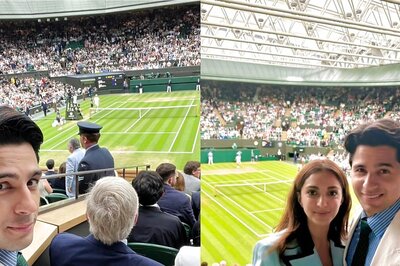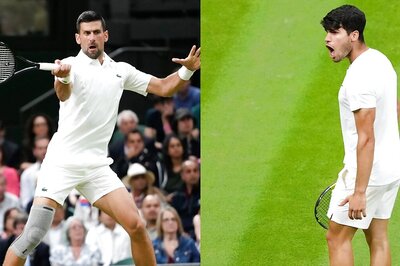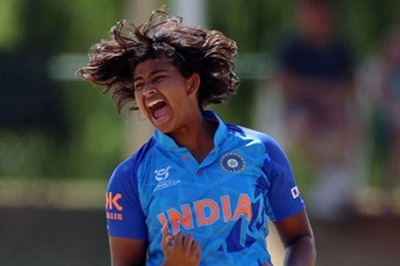
views
UNPAROGONED
The final score card -3-3-4-2
29 days of exhilarating FIFA World Cup action finally came to an end on Sunday, 18 December 2022, at the Lusail Stadium in Qatar, when Lionel Messi was crowned the world champion in the grand finale to his once-in-a-generation career, in the presence of 88000 spectators.
When Messi, the reigning Copa America Champion and 2008 Olympic Gold medalist led his nation to the World Cup victory, ticking the last empty box in his glittering soccer career, he not only emulated Diego Maradona, the reigning deity of Argentinian football but also made hurricane entry to the soccer hall of the fame, gilding his claim to be in the pantheon of the greatest like “Brazilian Pelé, the record three-time World Cup champion”.
What a moment!
In his fifth and definitely the last World Cup outing, Messi scaled the summit. In the process, he gave Argentina, five-time finalists, its third World Cup.
In a final that the posterity will remember as the paragoned classic, the finest World Cup final ever played, Messi scored two goals and a third in the shootout, denying France to become the first team in five decades to win consecutive World Cups, eclipsing the most sparkling comeback inspired by the mesmerising hat-trick by Kylian Mbappé, first such feat in the last 56 years in a FIFA World Cup final. It is befitting when it happened, Messi sank to his knees in the centre circle, engulfed by his teammates.
AND THE WINNER IS ….
After 64 scintillating and unforgettable matches over 29 days played by 32 teams, the cup is still retained in the ‘elite league of eight nations who have ever won the cup.’ But Qatar sends powerful messages — one, the game of soccer has unparalleled power to connect the people and the nations. Two, the winner in Qatar is ….“the football.”
MOMENTS TO CHERISH
What a cup.
It had no minnows. No Lilliputian nations. A tournament that brought the mighty down to knees. Where soccer greats were forced to bite the dust. Saudi Arabia trounced Argentina 2-1 in a stunning opener killing Messi’s dream. Almost. Unfancied Tunisia defeated the 2022 runner-up and 2018 champion France 1-0. Samurai Blue of Japan in group stage shocked mighty Spain and Germany both 2-1 and they lost the knockout match 3-1 to Croatia, who eventually finished third, only in the penalty shootout.
But it is the giant slayers of Morocco, who turned the real darlings of FIFA 2022. They broke the unmistakable 92-year-old glass ceiling that Africa faced at the football World Cups. 13 African nations have participated in the World Cup so far, but none reached the semifinals. Before Morocco, Cameroon (1990), Senegal (2002) and Ghana (2010) had ended in the quarter-finals.
Despite the snowball created due to the inability of African teams to cross the quarter-final Rubicon, largely owing to the continent’s economic disadvantages relative to Europe and South America, Morocco is the latest soccer heartthrob whose fodder on the way to the semi-final included the scalps of great footballing nations — Belgium (2-0), Canada (1-0), Spain (3-0) in the penalty shootout and Portugal (1-0). In the seven matches the Moroccan Bravehearts played, they went down fighting France (2-0) in the semi-final and Croatia (2-1) in the match for the third place but theirs has been a great story sporting the latest bedtime dancing and wild celebration.
OVER TO AMERICA
From Qatar, the grand stage now shifts to North America, where in 2026, 48 nations will vie for the FIFA World Cup for the first time (it was 32 till now) in 16 cities of USA, Mexico and Canada.
INDIA’S DREAM CHANCE
I am a daydreamer who has daydreams — “India’s first tryst with the FIFA World Cup will be in 2026 when 48 nations will play for the trophy. 8 of these teams will be from Asia.” And I believe in daydreams coming true. When I was a tiny-tot in 1969, India’s dreamer par excellence, Atal Bihari Vajpayee had dared me to dream big, with his poetic prophecy – “Bete Sapne Din Mein Dekhna, Woh Bhi Sitaron Ke Aage Ke. Sapne Sach Hote Hain (son, always daydream, and dream beyond the stars, daydreams come true).”
And my daydreams for Indian football are grounded in the ground.
In the 1948 Olympics, just months after independence, our Blue Tigers in their first match held France 1-1 till the 89th minute but lost valiantly in the last minute 2-1. And in the 1960 Olympics in Rome, piggybacking the magical goal of captain PK Banerjee, the Indian team held France 1-1. This year, the same France ended as the world cup runners-up to Argentina. Earlier, France went on to become the 1984 Olympic football gold medalist and the winner of the 1998 FIFA World Cup.
Also, in the 1956 Olympics, Blue Tigers of India taming host Australia 4-2 (Australia eliminated Denmark and Tunisia to reach knockout in Qatar in 2022), became the first nation from Asia to enter the Olympic semifinals, eventually losing to Yugoslavia and Bulgaria to finish fourth. Serbia and Croatia, sprouts of Yugoslavia, reached the 2022 knockout stage and Croatia eventually finished third, behind Argentina and France. Bulgaria has played 7 times so far in 7 editions of the World Cup and has also played the semifinal once.
Why doesn’t India play? It can. It will.
To actualize my audacious daydream, all the sleeping Blue Tigers have to do is unlock the DNA of the winning culture and play what I call the “Iceland Way.”
WHAT IS THE ICELAND WAY?
In 2018, at the Otkrytie Bank Arena, Moscow, also known as the Spartak Stadium, the baby on the prowl, the European tiny tot — Iceland — of merely 3,34,000 people and the smallest nation ever to play in the FIFA World Cup, stunned Leonel Messi’s Argentina 1-1 in its debut match, sending 99.6 percent Icelanders roaring in unison in the ecstasy before their TV sets. I call it unlocking the DNA of the winning culture –-“The Iceland Way.”
In less than six years, the tiny Iceland catapulted 113 places in FIFA rankings to “high 18th” (March 15, 2018), from a lowly low of 131st (June 6, 2012).
For India, the FIFA World Cup has been “a no-show, a distant dream.” for the last 92 years.
Can India of 2026 beat India of 2022?
My informed answer is a definite yes. Mission impossible is possible.
TIME TO DISCARD THE OPTIC ILLUSION
But if India of 2026, the most populous country of the world, has to be a soccer great nation aka Iceland (population 3.4 lakh), Croatia (population 40 lakh) or Morocco (population 370 lakh), it has to shed its optical illusion first.
We, the argumentative Indians, have burnt rims of papers over the optical illusion arguing why India did not play (refused or banned is a matter of detail) the fourth edition of the FIFA World Cup in 1950 in the presence of 2,00,000 fans at the world’s biggest stadium “the Maracana” in Rio de Janeiro, Brazil. But the truth beckons, we did not deserve to be there, having got the invite by default- in a grief-filled world in the aftermath of the bloody second world war, countries with better credentials (Argentina, Germany, Czechoslovakia and Hungary among others) either did not participate or boycotted the cup. All Brazil could get was 13 teams.
For us Indians, 1950 was the solitary chance. Playing in the World Cup has been an optical illusion ever since, notwithstanding that it is the world’s most popular sporting event, about which 95 percent of all sports fans are aware, and whose 2018 edition was watched by 3.7 billion people i.e., half the world’s population.
It is time to Wake up Sid!
TIME FOR INDIAN FOOTBALL TO EXIT THE HOSPICE
For a long time, Indian football has been in the ICU. In recent times, it has entered the hospice, where the terminally ill await death.
But it is time for the Indian football to convert the hospice into the Kashi Dham and take a vow to play in the 2026 edition of the FIFA World Cup like lions. All it has to do is look at the grand run of Indian Chess-with 77 grandmasters, India, today, is a giant slayer and a world beater.
TIME TO TAKE THE QUANTUM JUMP
India’s worst and best FIFA ranking has been 173 (2015) and 94 (1996). Currently, it is ranked 106 against tiny Iceland at 62.
All India needs to do is jump 60 FIFA places to play in the 2026 Cup and to make its entry certain, it has to be the 6th Asian rank nation (from the current 19th AFC ranking).
The task is arduous, but mission impossible is possible.
If Iceland, a nation of 3,34,000 souls, can jump 113 places in the rankings, we, the people of India, too can reach the 48th scale. If we do not clinch our half-chance now, “Indian football will plunge into an abyss deeper than the abyssal.”
ASIAN PEERS SHOW THE WAY
In the 2002 edition of the FIFA World Cup, host South Korea and Japan reached the knockout stage and two teams from Asia — South Korea and Turkey — played in the semifinals.
Cut to 2022- teams from Asia have glittered causing an upset of soccer majors- Saudi Arabia stunned champions Argentina while Japan gave waterloo moments to Germany and Spain. Three out of six teams from Asia progressed to the knockout stage where they showed nerves of the steel. Japan drew mighty Croatia 1-1 and went down in the penalty shootout; Australia valiantly fought the eventual winner Argentina 2-1 and South Korea lost to fancied world number one Brazil 4-1.
If smaller nations, who took to football much later than India, can do wonders, then why can’t we, with our past perfect?
THE PAST PERFECT
For the uninitiated, romance of India with football is a roller-coaster love story of more than 134 years, ever since in 1888, the Durand Cup was founded by the then India’s Foreign Secretary, Mortimer Durand.
Organised football has existed for over a century in India.
The Durand Cup football tournament, India’s oldest tournament started in 1888, the Rovers Cup in Mumbai in 1893 and the IFA Shield in Calcutta in 1891. The All-India Football Federation (AIFF) was formed in 1937 and got FIFA affiliation in 1939.
And from 1948 to 1964, India played in four Olympics, reached the semifinal in 1956 and won two Asian Games gold medals. It is time to reignite the romance of the past perfect.
Contrast it with Iceland. In 1958, the Icelandic team was a part of the qualification process for the FIFA World Cup, for the first time. However, they finished last in their group. This was because they had zero wins and conceded over 26 goals.
NO TIME TO LOSE
As the 19th-ranked team in Asia, India is lucky to get a bye in the AFC first round of the 2026 FIFA World Cup qualifications. But there is no time to lose with the AFC second round, which is likely to be played from mid-November 2023 to mid-June 2024. And the draw for the second round is tantalizingly close in July 2023.
WE HAVE 330 DAYS
India, it is a race against time. And your run began yesterday. Here are the primers to beat the odds.
One, with Asia’s quota doubling from 4.5 to 8.5 teams in 2026 World Cup, theoretically, Asia can clinch 9 spots, but India must aim for the 6th spot to be certain.
Two, as long as the country can retain its top 25 rank in Asia, it is certain to get six qualification matches. Every match has to be a must-win.
Three, “330 days Khelo-Khelo football.” Time to huff and puff is over. For the next 330 days, if need be, ban all cricket matches. Let all governments, PSUs, corporates and sports associations and every Indian dance to the tune of “Khelo Football- Khelo India, Khelo Bharat”. It is time to make Khelo Football a national mission- 330 days, 24×7 mania if India has to spot every hidden Indian Messi, Mbappé or Ronaldo. And who knows there is an Indian Pele hidden some where in an unknown tribe in distant jungles.
Four, we have to hone up all- togetherness, the hidden energy, positive attitude, great mindset, extraordinary physical and psychic fitness, world-class infrastructure, coaches and tactical strategy. Let’s just do it.
Five, in six months, India has to find the best talent, 10 teams consisting of 25 players each. If we scout in every village, every tribe, every district and every nook and corner, we can do it. India has to invent its own template for footballing excellence. What we need is 100 world-class coaches, let us get the very best. And I dare say, we can. Nothing constrains us.
Six, catch them young. Aged 18 years in the 2022 World Cup, Spanish teenage sensation Gavi got his name on the scoresheet against Costa Rica. He is the youngest in this edition to score a goal. Many recent greats- Messi (Argentina), Dmitri Sychev (Russia), Julian Green (USA), Divock Origi (Belgium), and all-time footballer great Pele shined first as teenagers. Let India find 11 such hidden stars.
Seven, Lionel Messi had to wait, and wait, and wait for the ultimate crown until he turned 35 and played his final World Cup. India has waited for 75 years and now is the time to end the wait.
Eight, it is time to reset the memory button. India’s past records in the world qualifiers is abysmal — India has only won nine of their 48 matches. And here lies the lesson — India has to win every qualifier to qualify. It means India still has a proverbial mountain to climb, to qualify for the World Cup. If it has to play in 2026, it has to be at the same level as Japan, Saudi Arabia, Australia, South Korea, Iran, Qatar and Uzbekistan. A tall order, yes. Impossible, no. So far, players like Sunil Chhetri have surfaced accidentally and not by design. We have to invert the pyramid at once. It is time for a revolutionary revolution in the way we scout, track and nurture footballers in the country.
Nine, footballing infrastructure is at the nadir. None can create, build and rebuild infrastructure faster than our armed forces and Indian railways. Empower them to create 1000 football stadiums and associated infrastructure in 100 days. They can do it. Let their creative powers be unleashed.
Ten, make no mistake, the task in hand is arduous – akin to climbing Mount Everest without the help of “Sherpas” to guide the path and Nepalese coolies to share the load and ironically without oxygen. But it is time for India, the inventor of “zero” to unleash the power of ‘144 crore Bharat Vanshi’ to dance to the wild tune of football the African way. And united, we can win the war.
Eleven, start playing as many international-friendly or competition matches as possible. It is worth remembering that when Guus Hiddink took over in January 2001 as South Korea’s coach, until the start of the 2002 World Cup, on May 31, South Korea played 26 internationals either in friendly matches or in tournaments abroad. And South Korea reached the semi-finals proving all pundits wrong.
Lastly, money is the problem. When an ordinary mortal like me, powered by steely footballer E Sreedharan (he was centre forward of the school team with legendary T N Sheshan as the goalkeeper), as chairman of Konkan Railway, could raise from the market resources worth $1 billion in the 1990s (in the aftermath of Harshad Mehta scam) to complete the signature Konkan Railway Project, we Indians can raise $10 billion in no time. Do not forget when Dorabji Tata established TISCO on 26 August 1907 to fulfill the dream of his father Jamsetji Tata, Tata raised all the money to complete the Tata Steel Jamshedpur plant in a few days. And, to tell you the truth, Indian freedom struggle was funded by ordinary Congress workers and their ten-rupee contribution.
Who said money will come in the way of actualising the dream of Indian football?
THE POSTSCRIPT
The nostrum above is the first baby step for India to play in the 2026 FIFA World Cup. Indian football suffers from deeper structural maladies and cancer has metastasized. If Indian football has to be resurrected, it needs a rapid-fire infusion of experimental medicines. And the beginning has to be ‘catch baby players’ 5-6 years old, track and nurture them, so that by the end of Amrut Kaal, India can turn world beaters.
Akhileshwar Sahay is a multi-disciplinary thought leader and India-based International Impact Consultant. He is a pathological daydreamer and an ardent football follower, who believes in the golden future of Indian Football. Views expressed are personal.
Read all the Latest Opinions here




















Comments
0 comment